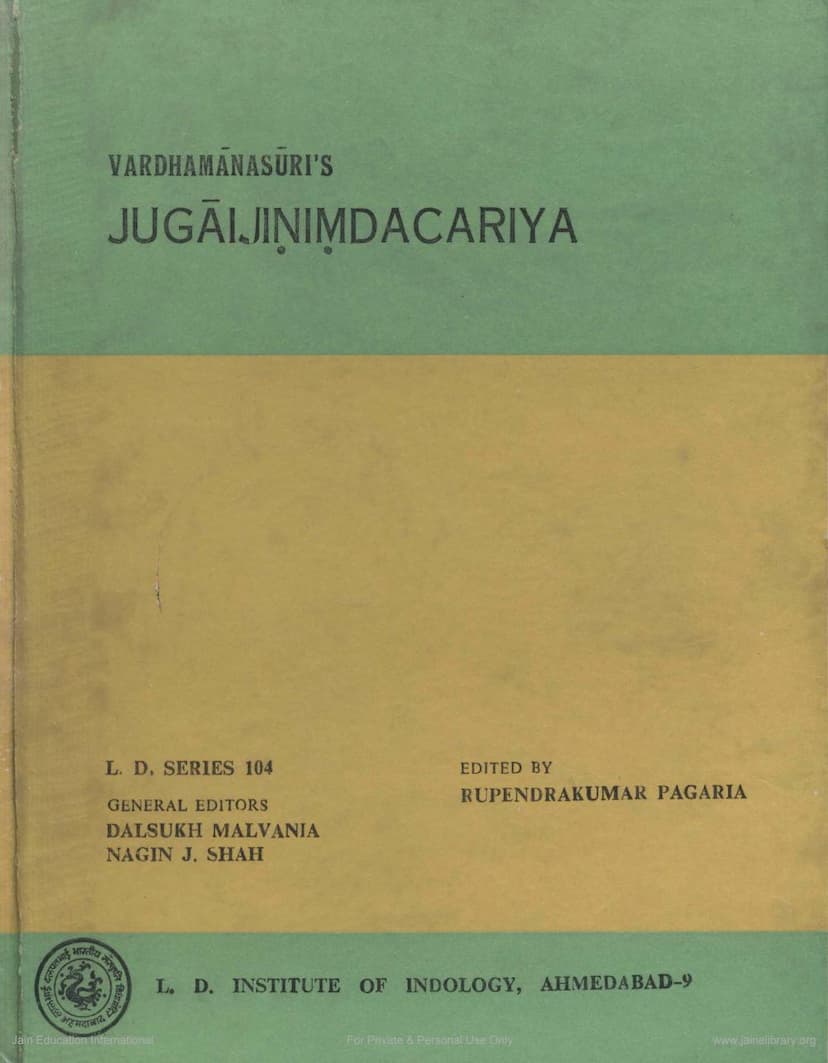Jugaijinandachariyam
Added to library: September 2, 2025

Summary
Based on the provided pages, here is a comprehensive summary of Vardhamanasuri's Jugāljinindachariyam (also known as Yugadi-jinendra-carita), focusing on its content, structure, and significance:
Book Title: Jugāljinindachariyam (or Yugādi-jinendra-carita) Author: Vardhamanasūri Editors: Rupendrakumar Pagariya, Dalsukh Malvania, Nagin J Shah Publisher: L. D. Indology, Ahmedabad L. D. Series: 104 First Edition: July, 1987
Overall Nature and Significance:
- Jugāljinindachariyam is a significant hitherto unpublished Prakrit work that provides a legendary biography of Rishabha, the first Jain Tirthankara.
- Composed in a blend of prose and verse, it is a voluminous work, estimated to be around 11,000 ślokas, showcasing an ornate Kāvya style in its descriptions.
- It belongs to a period (composed in 1160 V.S. - 1104 A.D.) when religious narratives were given elaborate literary treatment, often incorporating diverse styles, themes, and linguistic mediums within a single work.
- The text is notable for its inclusion of 44 secondary tales (avadāntar kathā), which enrich the primary narrative and offer insights into Jain principles, ethics, and broader Indian folklore traditions.
- The work is a valuable resource for scholars of Prakrit literature, Jainism, and Indian narrative traditions, shedding light on the development of Tirthankara biographies and the literary landscape of the 12th century.
Author and Context:
- Vardhamanasūri was a disciple of Abhayadevasūri, a renowned commentator of nine Jain Āgamas.
- The work was composed at Cambay (Khambhāt) in 1160 V.S. (1104 A.D.).
- The critical edition is based on two manuscripts: one from a Bhandara in Patan (paper manuscript) and another from the Palm-leaf MSS Library established by Jinabhadrusūri in Jesalmer Fort (palm-leaf manuscript). The Jaisalmer manuscript (designated 'Jē') was given preference in the editing.
Content and Structure:
The Jugāljinindachariyam recounts the life and teachings of Lord Rishabha, structured into five avadhikāras (sections/chapters), detailing his journey through multiple births and his ultimate attainment of liberation. The preface and table of contents (from the provided text) indicate the following key themes and narratives:
-
Introduction/Preface:
- Introduces Vardhamanasūri and his work.
- Discusses the manuscripts used for the edition.
- Highlights the importance of the work, its literary features, and the author's sources.
- Mentions the extensive use of secondary tales.
- Notes the inclusion of Apabhraṃśa passages, particularly the Raddā meter for the Bharata-Bahubali episode.
- Acknowledges the financial assistance from the Government of India for manuscript preservation.
-
Key Biographical Stages of Lord Rishabha:
- Thirteen Previous Births: The text details Rishabha's thirteen previous births, emphasizing the development of his spiritual essence (samyaiktva) and conduct (saṃyama) that led to his bondage of the Tirthankara karma. The first mention is of Dhanna Sārthavāha.
- Birth and Lineage: Covers the period before Lord Rishabha's final birth, describing the kulakaras (ancestors of humanity) and the establishment of lineage. It notes the 14 dreams of Marudevi, leading to Rishabha's birth.
- Name and Dynasty: Details the naming of Rishabha and the establishment of the Ikṣvāku dynasty.
- Marriage: Describes the marriages, including the context of the marriage of Rishabha's sons to the daughters of the Kūlcara.
- Renunciation and Enlightenment: Recounts Rishabha's great renunciation (mahāniṣkramaṇa) and his attainment of omniscience (kevalajñāna).
- First Sermon and Establishment of the Four-Fold Community: Details Rishabha's first sermon (dharmadeśanā) and the establishment of the four pillars of Jainism: monks (muni), nuns (āryikā), laymen (śrāvaka), and laywomen (śrāvaki).
- The Reign of Bharata and Bahubali: A significant portion is dedicated to the reign of Rishabha's son, Bharata, the Chakravarti (Emperor), and his brother Bahubali. This includes the famous Bharata-Bahubali battle, Bahubali's subsequent renunciation and omniscience.
- Nirvana: Concludes with the description of Lord Rishabha's liberation (nirvāṇa) and Bharata's eventual path to liberation.
-
Secondary Tales (Avāntara Kathā):
- The work is rich with approximately 45 secondary tales that illustrate Jain ethical principles like dāna (charity), śīla (virtue/chastity), tapas (austerities), and bhāvanā (meditation/contemplation).
- These tales often draw from popular Indian story traditions, including adaptations from the Pañcatantra (e.g., the Weaver's Son story, Physician's Sons, Man with Barley Meal, Hunter, Snake, Elephant, Fox, Impatient Dolt, Entrapped Suitors, Creation of a Golden Statue).
- Other notable tales include the story of Gabā sundara (illustrating the consequences of apostasy from Jainism), Nanda, Caṇakya, and Kunāla, and Śīladhana (illustrating chastity).
- Allegorical tales are also present, such as the Caravan Leader Dhana and the Honey Drop.
- The tales often depict the merits of adherence to Jain principles and the pitfalls of their violation, serving didactic purposes.
-
Linguistic and Literary Features:
- Multilingual Composition: The Prakrit is interspersed with Sanskrit ślokas and Apabhraṃśa passages, particularly for the Bharata-Bahubali conflict, using the Raddā meter.
- Ornate Kāvya Style: Descriptions are often in an ornate Kāvya style, demonstrating Vardhamanasūri's mastery of earlier literary traditions.
- Colloquialisms and Idioms: The text uses colloquial expressions, idioms, and proverbs, making it important for understanding the early history of Gujarati and related languages.
- Metrical Variety: While Āryā meter is frequently used in verses, the text also employs other meters like Vādanaka, Doha, Vastuvādanaka, Dvipadī, Paddhadi, Rāsāvalaya, and Raddā.
-
Thematic Elements:
- Illustrates the Jain doctrine of Karma through the multi-birth narratives.
- Emphasizes the path of liberation through righteousness, virtue, and austerities.
- Showcases the character of the first Tirthankara as an ideal leader and spiritual guide.
- Explores themes of morality, the consequences of actions, and the importance of right faith (samyaiktva).
In essence, Jugāljinindachariyam is a comprehensive and artistically rendered biography of Lord Rishabha, interwoven with a rich tapestry of secondary tales. It serves as a vital repository of Jain lore, linguistic evolution, and cultural narratives from medieval India.